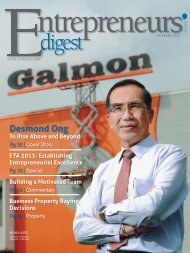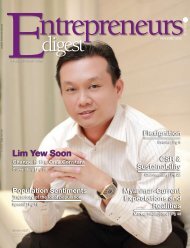ED 45
You also want an ePaper? Increase the reach of your titles
YUMPU automatically turns print PDFs into web optimized ePapers that Google loves.
42<br />
ma r k E t in t E l l i gE n c E<br />
The SenTimenTS from<br />
The Ground<br />
A snapshot of some of the business issues faced by local enterprises in<br />
these trying times.<br />
Rising costs, shortage of labour,<br />
insufficient cashflow are some of<br />
the recurrent and typical challenges<br />
that small and medium enterprises (SMEs)<br />
face in today’s capricious business<br />
environment. Faced with a shrinking<br />
and ageing population, the government<br />
has been advocating businesses to<br />
improve productivity. However, SMEs<br />
are finding it increasingly challenging and<br />
difficult to maintain the competitiveness<br />
and productivity of their businesses.<br />
The Association of Small and Medium<br />
Enterprises (ASME) recently commissioned<br />
a survey to establish the challenges faced<br />
by local SMEs in Singapore amidst the<br />
current business climate and prevailing<br />
government policies, as well as gather their<br />
feedback and business sentiments.<br />
Costs and Turnover<br />
Many SMEs have been facing and raising<br />
concerns as they see steady increases in<br />
labour, rental and operational costs. 79.6<br />
per cent of the SME respondents surveyed<br />
demonstrated that their current cost of<br />
operations have increased, with a majority<br />
of 40.1 per cent revealing that their current<br />
cost of operations have increased by over<br />
10 per cent, followed by the second highest<br />
poll of 28.2 per cent of them revealing<br />
that their current cost of operations have<br />
increased by over 20 per cent.<br />
has your current cost of operations:<br />
Decreased 6%<br />
Remained the same 14%<br />
Increased 80%<br />
sE p | Oc t 2012<br />
En t r E p r E n E u r s’ Di g E s t<br />
80%<br />
70%<br />
60%<br />
50%<br />
40%<br />
30%<br />
20%<br />
10%<br />
0%<br />
28.20%<br />
40.10%<br />
By less than 10%<br />
By more than 10%<br />
By over 20%<br />
11.30% 14.10% 3.50%<br />
2.80%<br />
Increase Remain the same Decrease<br />
75.6 per cent of the respondents are of<br />
the view that in the next three months<br />
ahead, they are estimating that their cost<br />
of operations will increase, and 76 per cent<br />
of SMEs whose current cost of operations<br />
have increased are still expecting their cost<br />
of operations to increase within the next<br />
three months. Only a mere 6.6 per cent<br />
of the respondents indicated that they<br />
are expecting their cost of operations to<br />
decrease.<br />
In the 3 months ahead do you see your cost of<br />
operations:<br />
80%<br />
70%<br />
60%<br />
50%<br />
40%<br />
30%<br />
20%<br />
10%<br />
0%<br />
20.70%<br />
31.90%<br />
23.00%<br />
17.80%<br />
Decreasing 7%<br />
Remained the<br />
same 18%<br />
Increasing 75%<br />
By less than 10%<br />
By more than 10%<br />
By over 20%<br />
0.70%<br />
Increase Remain the same<br />
4.40%<br />
Decrease<br />
1.50%<br />
39.3 per cent of the SMEs’ current turnover<br />
had increased whilst an almost equivalent<br />
35.3 per cent of them revealed that their<br />
current turnover had decreased.<br />
has your current turnover:<br />
Increased 80%<br />
40%<br />
35%<br />
30%<br />
25%<br />
20%<br />
15%<br />
10%<br />
5%<br />
0%<br />
11.30%<br />
14.00%<br />
By less than 10%<br />
By more than 10%<br />
By over 20%<br />
16.20%<br />
9.90%<br />
14.00% 25.40% 9.20%<br />
Increase Remain the same Decrease<br />
Decreased 6%<br />
Remained the same 14%<br />
Amongst all the respondents, the most<br />
number of SMEs indicated that their<br />
turnover remained the same, while 16.2 per<br />
cent of them, and also the second highest<br />
registered a decrease by over 20 per cent<br />
of its current turnover.<br />
When asked about SMEs’ short term view<br />
on their turnover, the majority of SMEs<br />
indicated that they are expecting to see an<br />
increase in their turnover in the three months<br />
ahead. However, a higher percentage of<br />
them expect turnover to remain the same<br />
as their current figures.<br />
Employment Plans<br />
Despite the uncertain economic outlook<br />
amidst the Eurozone Crisis, US’ and<br />
China’s economic slowdown, as well as<br />
a weakening job market, SMEs are still<br />
looking into hiring and increasing their staff<br />
strength. Interestingly, 48.1 per cent have<br />
revealed that they will be increasing their<br />
staff strength for the next six months, while<br />
40.7 per cent of them demonstrated no<br />
change to their staff strength within the next<br />
six months.<br />
SMEs' employment plans for the next 6 months:<br />
However, this trend also highlights the<br />
manpower shortage issues that SMEs<br />
are facing, which explains the reason<br />
why SMEs are looking into hiring. Given<br />
the fact that most SMEs are looking at<br />
increasing staff strength, and only 11.1<br />
per cent of them indicated that they have<br />
intentions to decrease staff strength, the<br />
paradox of having difficulty hiring locals<br />
becomes a pertinent issue.<br />
overseas Expansion and Relocation<br />
Plans<br />
62 per cent of the SME respondents<br />
indicated their intention to expand/relocate<br />
overseas. Of the SMEs intending to expand<br />
their businesses overseas, a majority of<br />
them are looking to expand to neighbouring<br />
countries in the Southeast Asian region.<br />
The top three countries within the region<br />
are Indonesia, Malaysia and Vietnam. This<br />
is perhaps due to the proximity and good<br />
network and connections in relation to<br />
these selected southeast Asian countries.<br />
Within Asia, China remains the popular<br />
choice for expansion, followed by India.<br />
Rising costs has inevitably drove SMEs<br />
to relocate to other regions where<br />
labour, land and raw materials are<br />
cheaper. Considering how Singapore’s<br />
neighbouring countries are actively<br />
opening up and developing, it is no<br />
surprise that SMEs will search for other<br />
cheaper alternatives to re-shift their<br />
business operations.<br />
It is also worthy to note that with the slew<br />
of new policies imposed, many SMEs<br />
are concerned how these regulations will<br />
negatively affect their industries. There<br />
Decrease staff strength 11%<br />
Increase staff strength 48%<br />
No change to staff strength 41%<br />
are still many jobs available out there for<br />
locals but many SMEs still have difficulty<br />
recruiting local manpower in the market<br />
and hence find it difficult to meet the<br />
foreign labour quota. With whatever little<br />
manpower that is left and are available<br />
to SMEs, many locals are not committed<br />
and are unwilling to work especially in<br />
the lower tiered jobs, such as drivers,<br />
waitresses, etc.<br />
Despite Singapore’s push to improve<br />
productivity, SMEs face the challenge of<br />
locals reluctant to increase productivity<br />
or are unwilling to work overtime even<br />
though their salary has been increased.<br />
Key Strategies<br />
Going forward, SMEs are looking towards<br />
expanding their existing range of products<br />
and services, and enhancing their branding<br />
and marketing presences. This includes<br />
offering new products and services or<br />
extending their existing products and<br />
service lines.<br />
Other than the aforementioned plans to<br />
expand/relocate to the overseas market, a<br />
majority of them are also looking to increase<br />
productivity through training as well as<br />
enhancing their existing capabilities in terms<br />
of innovation, R&D, technology, etc., which<br />
ma r k E t in t E l l i gE n c E<br />
are in line with Singapore’s recent policies<br />
to improve productivity.<br />
Taking a closer examination on SMEs<br />
whose cost has increased and what their<br />
key strategies are for the next six months,<br />
the survey results found that out of the 79.6<br />
per cent whose current cost of operations<br />
had increased, more than half of them<br />
indicated that one of their key strategies is<br />
to expand their existing range of products<br />
and services, while 48 per cent indicated<br />
that they will enhance their branding and<br />
market presences.<br />
It is also noteworthy that many whose cost<br />
operations has increased are looking into<br />
taking steps to contain their costs such as<br />
relocating, expanding overseas as well as<br />
streamlining their operations.<br />
In Conclusion<br />
Looking ahead, SMEs are generally<br />
optimistic in terms of their turnover, with<br />
a slightly higher percentage of them<br />
expecting their turnover to increase in the<br />
short term. However, there are still SMEs<br />
who are tightening their business outlook<br />
with a higher percentage of them revealing<br />
that they expect their turnover for the next<br />
three months ahead to remain the same.<br />
The two most pertinent issues are rising<br />
costs and manpower shortages. Amidst<br />
these challenges faced, SMEs are taking<br />
strategic steps to differentiate themselves<br />
from their industry peers, as well as taking<br />
steps which will improve their productivity.<br />
SMEs are also looking at other alternatives<br />
to ensure the competitiveness, sustainability<br />
and profitability of their business, for e.g.<br />
relocating and expanding overseas.<br />
Many SME owners have raised their<br />
concerns over the recent policies<br />
aforementioned. With the government<br />
taking more initiative to gather feedback<br />
and ground sentiments to better implement<br />
multi-pronged policies, this survey will also<br />
serve as a platform to consolidate and<br />
highlight the challenges, feedback and<br />
solutions that SMEs have raised, to higher<br />
authority.<br />
sE p | Oc t 2012<br />
En t r E p r E n E u r s’ Di g E s t<br />
43












